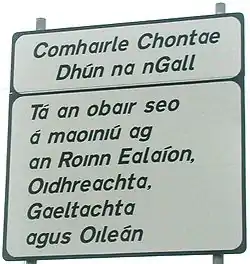Tittle
A tittle or superscript dot[1] is a small distinguishing mark, such as a diacritic in the form of a dot on a lowercase i or j. The tittle is an integral part of the glyph of i and j, but diacritic dots can appear over other letters in various languages. In most languages, the tittle of i or j is omitted when a diacritic is placed in the tittle's usual position (as í or ĵ), but not when the diacritic appears elsewhere (as į, ɉ).

Use
The word tittle is rarely used.[2] One notable occurrence is in the King James Bible at Matthew 5:18: "For verily I say unto you, Till heaven and earth pass, one jot or one tittle shall in no wise pass from the law, till all be fulfilled" (KJV). The quotation uses them as an example of extremely minor details. The phrase "jot and tittle" indicates that every small detail has received attention.
In the Greek original translated as English "jot and tittle" are found the words iota and keraia (Greek: κεραία).[3] Iota is the smallest letter of the Greek alphabet (ι); the even smaller iota subscript was a medieval introduction. Alternatively, it may represent yodh (י), the smallest letter of the Hebrew and Aramaic alphabets (to which iota is related). "Keraia" is a hook or serif, possibly referring to other Greek diacritics, or possibly to the hooks on Hebrew letters (ב) versus (כ) or cursive scripts for languages derived from Aramaic, such as Syriac, written in Serṭā (ܣܶܪܛܳܐ, 'short line'),[4] or for adding explicit vowel marks such as crowns (e.g. the Vulgate apex) known as Niqqud that developed with later scribal practices in the Torah. A keraia is also used in printing modern Greek numerals. In many abjads only consonants such as yodh in Hebrew have character forms; a word's phonetic pronunciation depends on unwritten or indistinct vowel markings such that many meanings can be rendered ambiguous or corrupted via oral transmission over time.
Dotless and dotted i

_-_c.34_-_cropped_on_b%C3%AD_and_b%E1%BB%89.png.webp)


A number of alphabets use dotted and dotless I, both upper and lower case.
In the modern Turkish alphabet, the absence or presence of a tittle distinguishes two different letters representing two different phonemes: the letter "I" / "ı", with the absence of a tittle also on the lower case letter, represents the close back unrounded vowel [ɯ], while "İ" / "i", with the inclusion of a tittle even on the capital letter, represents the close front unrounded vowel [i]. This practice has carried over to several other Turkic languages, like the Azerbaijani alphabet, Crimean Tatar alphabet, and Tatar alphabet.
In some of the Dene languages of the Northwest Territories in Canada, specifically North Slavey, South Slavey, Tłı̨chǫ and Dëne Sųłıné, all instances of i are undotted to avoid confusion with tone-marked vowels í or ì. The other Dene language of the Northwest Territories, Gwich’in, always includes the tittle on lowercase i.
There is only one letter I in Irish, but i is undotted in the traditional uncial Gaelic script to avoid confusion of the tittle with the buailte overdot found over consonants. Modern texts replace the buailte with an h, and use the same antiqua-descendant fonts, which have a tittle, as other Latin-alphabet languages. However, bilingual road signs use dotless i in lowercase Irish text to better distinguish i from í. The letter "j" is not used in Irish other than in foreign words.
In most Latin-based orthographies, the lowercase letter i loses its dot when a diacritical mark, such as an acute or grave accent, is placed atop the letter. However, the tittle is sometimes retained in some languages. In the Baltic languages, the lowercase letter i sometimes retains a tittle when accented.[5] In Vietnamese in the 17th century,[6] the tittle is preserved atop ỉ and ị but not ì and í, as seen in the seminal quốc ngữ reference Dictionarium Annamiticum Lusitanum et Latinum. In modern Vietnamese, a tittle can be seen in ì, ỉ, ĩ, and í in cursive handwriting and some signage. This detail rarely occurs in computers and on the Internet, due to the obscurity of language-specific fonts. In any case, the tittle is always retained in ị.
Phrases
- It is thought that the phrase "to a T" is derived from the word tittle because long before "to a T" became popular, the phrase "to a tittle" was used.[7]
- The phrase "to dot one's I's and cross one's T's" is used figuratively to mean "to put the finishing touches to" or "to be thorough".
References
- Oxford Dictionaries Online (US) — Is there a name for the dot above the letters i and j?
- nGram: tittle
- Blue Letter Bible
- Grammatical analysis of Syriac Peshitta Gospel of Matthew verse 5:18
- Wells, John C. (2001). "Orthographic diacritics and multilingual computing". Language Problems and Language Planning. Amsterdam: John Benjamins Publishing Company. 24 (3). ISSN 0272-2690.
A further complication is the convention of removing the dot from i and j when adding a diacritic over them, as in í, ì, î, ĵ. In the Baltic countries, however, the dot is sometimes retained in these circumstances.
- de Rhodes, Alexander (1651). Dictionarium Annamiticum Lusitanum et Latinum. Rome: Sacred Congregation for the Propagation of the Faith.
- Where did the phrase "to the T" come from?
Sources
External links
| Wikimedia Commons has media related to Hard-dotted letters. |